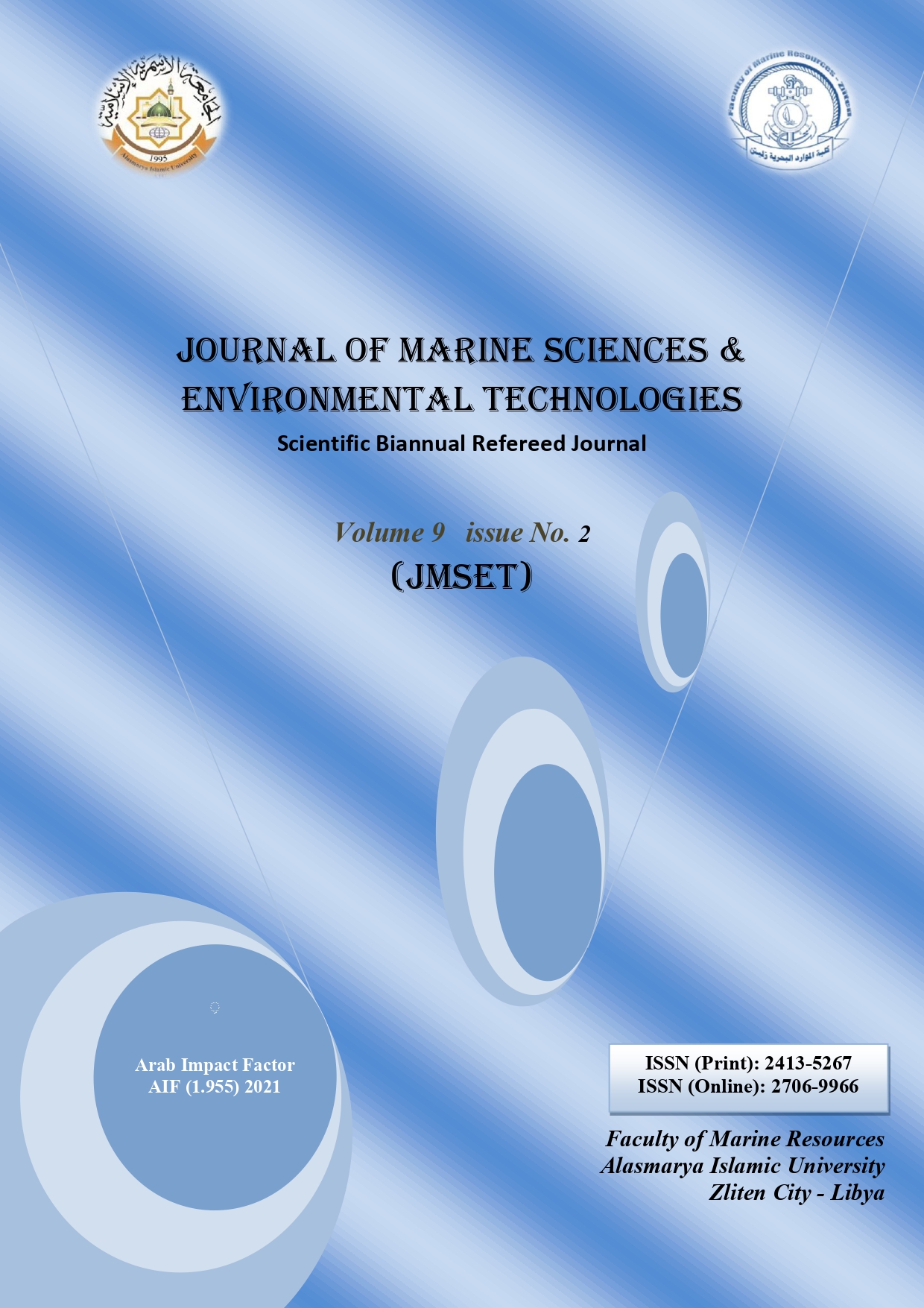Environmental Study about Sirte Sabkhas Impact on The Surface Salinity at Western Coastal of Libya Using MODIS Satellite Techniques
DOI:
https://doi.org/10.59743/jmset.v9i2.144Keywords:
Environmental study, Modis, Surface Salinity, Sabkhas, SirteAbstract
In this study, MODIS sensor techniques were used because of their quality images, and their data is available for seven years (2015-2021) to surface salinity in the study area. It was discovered that Sirte Sabkhas contributed to the surface salinity of the Libyan western coast. Surface salinity degrees were more intense in the summer and spring seasons and less in the winter and autumn seasons due to the feeding of Sirte Sabkhas. The south, southeast, and southwest winds had an important role in Sirte Sabkhas's effect on surface salinity on the western coast. The differences between salinity values during study seasons are considered evidence of the Sabkhas' impact.
Downloads
References
Aronica, G. T. & Candela, A. (2007). Derivation of flood frequency curves in poorly gauged Mediterranean catchments using a simple stochastic hydrological rainfall-runoff model. Journal of Hydrology, 3(7),132-142. DOI: https://doi.org/10.1016/j.jhydrol.2007.09.011
Assiry, A. M. Sastry, S. K., & Samaranayake, C. P. (2006). Influence of temperature, electrical-conductivity, power and pH on ascorbic acid degradation kinetics during ohmicheating using stainless steel electrodes. Bioelectrochemistry, 6(8), 7–13. DOI: https://doi.org/10.1016/j.bioelechem.2005.02.005
Bellerby, R. G. J., Schulz, K. G., Riebesell, U., Neill, C., Nondal, G., Johannessen, T., & Brown, K. R. (2007). Marine ecosystem community carbon and nutrient uptake stoichiometry under varying ocean acidification during the PeECE III experiment. Biogeosciences, 5(2), 1517-1527. DOI: https://doi.org/10.5194/bg-5-1517-2008
Borghini, M. H., Bryden, L., Schroeder, M., Sparnocchia, F., & Vetrano, A. (2014). The Mediterranean is becoming saltier. Istituto di Scienze Marine, Italy. Ocean Sci., 10, 693-700. DOI: https://doi.org/10.5194/os-10-693-2014
Britannica (2020). Dissolved inorganic substances. Available at: [https://www.britannica.com/science-/seawater/Dissolved-inorganic-substances].
Cael, B. & Ferrari, R. (2017). The ocean’s saltiness and its overturning. Geophysical Research Letters, 44(4), 1886–1891. DOI: https://doi.org/10.1002/2016GL072223
Cullum, J., Stevens, D. P., & Joshi, M. M. (2016). Importance of ocean salinity for climate and habitability. Proceedings of the National Academy of Sciences, 113(16), 4278–4283. DOI: https://doi.org/10.1073/pnas.1522034113
Encyclopedia Britannica (2015). Mediterranean Sea. Retrieved, p. 23.
Foudriest (2022). Algae, Phytoplankton and Chlorophyll. Available at: [https://www.fondriest.com/-environmental-measurements/parameters/water-quality/algae-phytoplankton-chlorophyll/].
Fu, Y. F. & Liu G. S. (2003). Precipitation characteristics in mid-latitude East Asia as observed by TRMM PR and TMI. J. Meteor. Soc. Japan, 81, 1353–1369. DOI: https://doi.org/10.2151/jmsj.81.1353
Funda, D. (2012). Salinity and seawater intrusion into the ground water. Indian Journal of Science and Technology 5(12), 3770-3775. DOI: https://doi.org/10.17485/ijst/2012/v5i12.17
Hamuna, B., Paulangan Y. P., & Dimara, L. (2015). Sea Surface Temperature Study Using Aquam-MODIS Satellite Data in Jayapura, Papua Waters. Depik., 4(3): 160-167. DOI: https://doi.org/10.13170/depik.4.3.3055
Michela, S., Salvatore, A., Orcid, R., Santoleri, O., & Bruno, B. N. (2021). Retrieving Mediterranean Sea Surface Salinity Distribution and Interannual Trends from Multi-Sensor Satellite and in Situ Data. Remote Sensing J., 3(5), 26-43.
Millot, C. (2017). Coastal eddies and salinity surface in east of Mediterranean Sea. Oceanol. Acta, 2(7), 261-273.
Moore, Z., Assouline S., Tanny, J., Lensky, I. M., & Lensky, N. G. (2018). Effect of Water Surface Salinity on Evaporation: The Case of a Diluted Buoyant Plume over the Dead Sea. Water Resources Research, 5(3), 1460-1474. DOI: https://doi.org/10.1002/2017WR021995
NASA (2002). Ocean Data. Available at: [https://oceandata. sci.gsfc.nasa.gov/Aquarius].
Palacios, S. L., Peterson, T. D., & Kudela, R. M. (2009). Development of synthetic salinity from remote sensing for the Columbia River plume. Journal of Geophysical Research: Oceans, 114(C2). DOI: https://doi.org/10.1029/2008JC004895
Reverdin, G., Kestenare, E., Frankignoul, C., & Delcroix, T. (2007). Surface salinity in the Atlantic Ocean (30◦S-50◦N). Progress In: Oceanography, (4)3, 311-342. DOI: https://doi.org/10.1016/j.pocean.2006.11.004
Smith, R. O., Bryden, H. L., & Stansfield, K. (2013). Observations of new western Mediterranean deep water formation using Argo floats. Ocean Sci.,12(4), 133-149. DOI: https://doi.org/10.5194/os-4-133-2008
Stammer, D., Ray, R. D., Andersen, O. B., Arbic, B. K., Bosch, W., Carrère, L., & Yi, Y. (2014). Accuracy assessment of global barotropic ocean tide models. Reviews of Geophysics, 52(3), 243-282. DOI: https://doi.org/10.1002/2014RG000450
Union of Concerned Scientists (2019). Climate Hot Map. Global Warming Effects around the World. Health. Available at: [http://www.climatehotmap.org/global-warming-effects/health.html].
Downloads
Published
Issue
Section
License
Copyright (c) 2023 Journal of Marine Sciences and Environmental Technologies

This work is licensed under a Creative Commons Attribution 4.0 International License.









